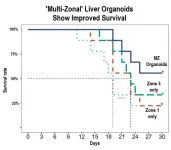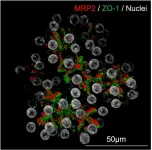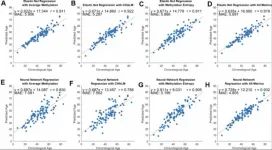(Press-News.org) One reason why our livers excel at clearing waste from our blood system is that the organ functions according to three key “zones” that perform specific major tasks. So, if scientists hope to create self-growing patches of liver organoid tissue that could help repair damaged organs, it’s important that the lab-grown tissue faithfully reproduce such zones.
In a groundbreaking paper published April 16, 2025, in the prestigious journal Nature, a team of organoid medicine experts at Cincinnati Children’s reports achieving just such a milestone – made from human stem cells. When these humanized organoids were transplanted into rodents whose own liver-bile duct system had been disconnected, the improved organoids nearly doubled the rodents’ survival rate.
“The research community has long needed a better model for studying human liver biology and disease, because there are outstanding hepatocyte diversity and associated functional orchestrations in the human liver that do not exist in rodents,” says Takanori Takebe, MD, PhD, the study’s corresponding author. “This new system paves the way for studying, and eventually treating, a wide range of otherwise fatal liver disorders.”
Takebe is Director for Commercial Innovation at Cincinnati Children’s Center for Stem Cell and Organoid Medicine (CuSTOM). He has been studying methods for growing liver organoids for over 13 years. Breakthroughs from his lab include producing the first connected set of three organoids grown together, a novel way to mass produce liver organoids for research purposes, and gene-engineered liver organoids that may someday help treat severe jaundice.
In the short term, these multi-zonal liver organoids will help scientists shed new light on diseases including diabetes, drug-induced liver injury, alcohol-related liver disease, and viral hepatitis. In turn, such work could accelerate drug development and other approaches to restore liver health.
Longer-term, for people on waiting lists for liver transplantation, this study moves the medical community one step closer to “growing” a patient’s own liver replacement tissue instead of relying on organ donation.
Currently, more than 9,000 Americans are registered on waiting lists to receive a liver transplant, according to the federal Organ Procurement and Transplantation Network. Every year, an estimated 2,000 people die waiting lists, while far more people never become eligible.
“This discovery is exciting for multiple reasons,” says Aaron Zorn, PhD, Co-Director of CuSTOM. “At one level, it shows that we have taken a significant step forward at growing liver tissue in the lab that accurately mimic human liver function. While human liver organoid transplantation remains at least several years away, in the lab, these special tissues may help us find ways to prevent people from ever needing a liver transplant.”
What’s next?
The new study lays out numerous details of how the new organoids were developed, and how they function – including genetic information down to the single-cell level. But even more research is needed to fully understand how the organoids match up with natural human organ development.
Scientists also are working to develop chemical methods rather than genetic editing to trigger zonal development in the new organoids. This would make it more practical to study disease development and drug responses at a personal level.
In the near-term, however, using these new liver organoids in lab settings to more accurately predict drug metabolism and toxicity may be the biggest medical impact that this innovation will have, Zorn says.
About the study
Cincinnati Children’s co-authors include Hasan Al Reza, MS, Connie Santangelo, MS, Abid Al Reza, PhD, Kentaro Iwasawa, MD, PhD, Kathryn Glaser, MS, Alexander Bondoc, MD, and Jonathan Merola, MD, PhD.
This study was supported by members of several shared facilities at Cincinnati Children’s: the Confocal Imaging Core, Pathology Research Core, Pluripotent Stem Cell Facility, Transgenic Animal and Genome Editing Core, Veterinary Services Facility, and Single Cell Genomics Core.
Funding sources for this work include a Cincinnati Children’s Research Foundation CURE grant, a Falk Transformational Award, an NIH Director’s New Innovator Award (DP2 DK128799-01), NIH grant (R01DK135478), grants from the Japan Agency for Medical Research and Development, and support from the Takeda Science Foundation and the Mitsubishi Foundation.
END
New human “multi-zonal” liver organoids improve injury survival in rodents
Experts at Cincinnati Children’s report breakthrough that could speed drug development, eventually lead to repair tissues to reduce need for full-organ transplantation
2025-04-16
ELSE PRESS RELEASES FROM THIS DATE:
Scientists achieve record-breaking growth in miniature, functional liver models
2025-04-16
Replicating the liver’s complexity
While organoids aim to mimic human organs, the liver’s repertoire of complex functions – and thus the energy it needs to operate – have made it challenging for researchers to grow organoids that proliferate and fully function, says Sato. When prioritizing growth and survival in laboratory settings, hepatocytes, the liver’s main cells, eventually transformed into cells resembling cholangiocytes, which line the bile duct. Hepatocyte functions only lasted 1-2 weeks at most.
The study team, led by Ryo Igarashi and Mayumi Oda at the Keio University School of Medicine, ...
Novel machine learning model can predict material failure before it happens
2025-04-16
A team of Lehigh University researchers has successfully predicted abnormal grain growth in simulated polycrystalline materials for the first time—a development that could lead to the creation of stronger, more reliable materials for high-stress environments, such as combustion engines. A paper describing their novel machine learning method was recently published in Nature Computational Materials.
“Using simulations, we were not only able to predict abnormal grain growth, but we were able to predict it far in advance of ...
Hereditary Alzheimer’s: Blood marker for defective neuronal connections rises early
2025-04-16
Individuals with a genetic predisposition to Alzheimer’s disease show altered blood levels indicating damaged neuronal contacts as early as 11 years before the expected onset of dementia symptoms. This is evident in the levels of the protein “beta-synuclein”. An international team, including researchers from DZNE, Ulm University Hospital and University Medicine Halle report these findings in the journal “Alzheimer’s & Dementia”. The biomarker studied here could potentially help to detect neurodegeneration at an early stage and thus ...
Nature-based activity is effective therapy for anxiety and depression, study shows
2025-04-16
Researchers evaluating a nature-based programme of activities for patients with mild to moderate mental health conditions have shown that improvements in mood and anxiety levels can be seen in as little as 12 weeks.
As part of the UK government’s commitment to transform mental health services, seven ‘test and learn’ green social prescribing sites were identified across England, which included a programme in Humber and North Yorkshire - the first of the seven sites to publish results from the national programme.
Green social prescribing is a practice whereby a healthcare professional refers a patient to community-based nature activities ...
New genomics tool accelerates biomedical breakthroughs
2025-04-16
A University of Virginia School of Medicine scientist and collaborators have developed a much-needed new tool to increase the efficiency of genomic research and accelerate the development of new ways to improve human health.
UVA researcher Nathan Sheffield, PhD, has spent four years developing a new data standard to ensure that scientists are comparing apples to apples when doing genomic analysis. This type of analysis helps researchers understand the operating instructions for our cells and see how those instructions are carried out. The resulting insights help us understand the workings of both healthy cells and unhealthy ones, pointing us to new ways to treat and prevent disease.
Genomics ...
DNA methylation entropy: A new way to track and predict aging
2025-04-16
“We find that epigenetic clocks based on the entropy of methylation states predict chronological age with similar accuracy as common approaches that are based on methylation levels of individual cytosines.”
BUFFALO, NY — April 16, 2025 — A new research paper was published in Aging (Aging-US) Volume 17, Issue 3, on March 12, 2025, titled “DNA methylation entropy is a biomarker for aging.”
Researchers Jonathan Chan, Liudmilla Rubbi, and Matteo Pellegrini from the University of California, Los Angeles, led a study that discovered a new way to measure changes in DNA that can help predict a person’s ...
Mount Sinai Fuster Heart Hospital recognized by Press Ganey for patient experience excellence
2025-04-16
The Mount Sinai Fuster Heart Hospital’s cardiology faculty practice has received the 2024 Human Experience Pinnacle of Excellence Award® from Press Ganey, one of the nation’s leading patient experience organizations.
The faculty practice is located at The Mount Sinai Hospital and has several physicians with top expertise in cardiovascular care. It is one of 10 heart centers across the country, and the only one in New York, to receive this prestigious award placing it on the leading ...
Nurturing now, thriving later: The lasting power of affectionate mothering
2025-04-16
Affectionate mothering in childhood may have a lasting impact on important personality traits, potentially influencing life outcomes such as educational achievement, economic success, and health and well-being, according to research published by the American Psychological Association. The findings suggest that positive maternal parenting could foster important traits such as openness, conscientiousness and agreeableness.
“Personality traits are strong predictors of important life outcomes, from academic and career success to health and well-being,” ...
A step toward harnessing clean energy from falling rainwater
2025-04-16
When two materials come into contact, charged entities on their surfaces get a little nudge. This is how rubbing a balloon on the skin creates static electricity. Likewise, water flowing over some surfaces can gain or lose charge. Now, researchers reporting in ACS Central Science have harnessed the phenomenon to generate electricity from rain-like droplets moving through a tube. They demonstrate a new kind of flow that makes enough power to light 12 LEDs.
“Water that falls through a vertical tube generates a substantial amount of electricity by using a specific pattern of water flow: plug flow,” says Siowling Soh, the study’s corresponding ...
Term or permanent life insurance? A new study offers guidance
2025-04-16
COLUMBUS, Ohio – A new study offers clarity on one of the most common questions asked of financial professionals: Is term or permanent life insurance right for me?
Researchers at The Ohio State University conducted a study of how different life insurance product types were related to whether households had adequate financial resources if an income earner died.
They didn’t compare permanent and term life insurance directly, but they calculated how likely households with different life ...
LAST 30 PRESS RELEASES:
Making lighter work of calculating fluid and heat flow
Normalizing blood sugar can halve heart attack risk
Lowering blood sugar cuts heart attack risk in people with prediabetes
Study links genetic variants to risk of blinding eye disease in premature infants
Non-opioid ‘pain sponge’ therapy halts cartilage degeneration and relieves chronic pain
AI can pick up cultural values by mimicking how kids learn
China’s ecological redlines offer fast track to 30 x 30 global conservation goal
Invisible indoor threats: emerging household contaminants and their growing risks to human health
Adding antibody treatment to chemo boosts outcomes for children with rare cancer
Germline pathogenic variants among women without a history of breast cancer
Tanning beds triple melanoma risk, potentially causing broad DNA damage
Unique bond identified as key to viral infection speed
Indoor tanning makes youthful skin much older on a genetic level
Mouse model sheds new light on the causes and potential solutions to human GI problems linked to muscular dystrophy
The Journal of Nuclear Medicine ahead-of-print tip sheet: December 12, 2025
Smarter tools for peering into the microscopic world
Applications open for funding to conduct research in the Kinsey Institute archives
Global measure underestimates the severity of food insecurity
Child survivors of critical illness are missing out on timely follow up care
Risk-based vs annual breast cancer screening / the WISDOM randomized clinical trial
University of Toronto launches Electric Vehicle Innovation Ontario to accelerate advanced EV technologies and build Canada’s innovation advantage
Early relapse predicts poor outcomes in aggressive blood cancer
American College of Lifestyle Medicine applauds two CMS models aligned with lifestyle medicine practice and reimbursement
Clinical trial finds cannabis use not a barrier to quitting nicotine vaping
Supplemental nutrition assistance program policies and food insecurity
Switching immune cells to “night mode” could limit damage after a heart attack, study suggests
URI-based Global RIghts Project report spotlights continued troubling trends in worldwide inhumane treatment
Neutrophils are less aggressive at night, explaining why nighttime heart attacks cause less damage than daytime events
Menopausal hormone therapy may not pose breast cancer risk for women with BRCA mutations
Mobile health tool may improve quality of life for adolescent and young adult breast cancer survivors
[Press-News.org] New human “multi-zonal” liver organoids improve injury survival in rodentsExperts at Cincinnati Children’s report breakthrough that could speed drug development, eventually lead to repair tissues to reduce need for full-organ transplantation





